Sopwith Camel Video - Startup and flight
|
|
|
|
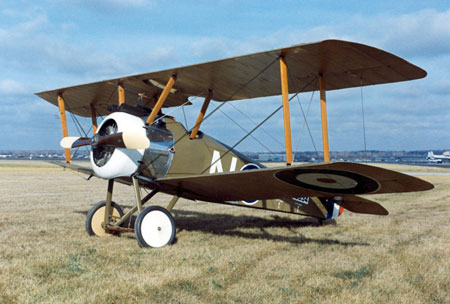 |
Crew: 1 Length: 18 ft 9 in (5.71 m) Wingspan: 26 ft 11 in (8.53 m) Height: 8 ft 6 in (2.59 m) Maximum speed: 115 mph (185 km/h) Stall speed: 48 mph (77 km/h) Range: 300 mi ferry (485 km) Service ceiling 21,000 ft (6,400 m) Rate of climb: 1,085 ft/min (5.5 m/s) |
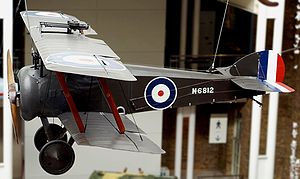 (Image:
A Sopwith Camel at the Imperial War Museum, London)
(Image:
A Sopwith Camel at the Imperial War Museum, London)
Role: Biplane fighter
Manufacturer: Sopwith Aviation Company
First flight: December 1916
Introduction: June 1917
Primary users: RFC (RAF), RNAS, AAF
Number built: 5,490
The Sopwith Camel was a British World War I single-seat fighter biplane, famous for its maneuverability.
Design and development
Intended as a replacement for the Sopwith Pup, the Camel prototype first flew in December 1916, powered by a 110 hp Clerget 9Z. Known as the "Big Pup" early on in its development, the aircraft was armed with two .303 in (7.7 mm) Vickers machine guns mounted in the cowl, firing forward through the propeller disc. A fairing surrounding the gun installation created a hump that led to the name Camel. The bottom wing had dihedral but not the top, so that the gap between the wings was less at the tips than at the roots. Approximately 5,490 units were ultimately produced.
Operational history
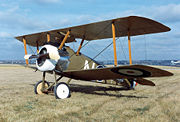 (Image:
Replica of Camel F.I flown by Lt. George A. Vaughn Jr., 17th Aero Squadron)
(Image:
Replica of Camel F.I flown by Lt. George A. Vaughn Jr., 17th Aero Squadron)
The type entered squadron service in June 1917 with No. 4 Squadron of the Royal Naval Air Service, near Dunkirk. The following month, it became operational with No. 70 Squadron of the Royal Flying Corps. By February 1918, 13 squadrons were fully equipped with the Camel.
Unlike the preceding Pup and Triplane, the Camel was not considered pleasant to fly. The Camel owed both its extreme maneuverability and its difficult handling characteristics to the grouping of the engine, pilot, guns, and fuel tank within the first seven feet of the aircraft, coupled with the strong gyroscopic effect of the rotary engine.
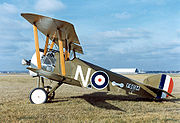 (Image:
This aircraft is currently displayed at the National Museum of the United States Air Force)
(Image:
This aircraft is currently displayed at the National Museum of the United States Air Force)
The Camel soon gained an unfortunate reputation with student pilots. The Clerget engine was particularly sensitive to fuel mixture control, and incorrect settings often caused the engine to choke and cut out during takeoff. Many crashed due to mishandling on takeoff when a full fuel tank affected the center of gravity. In level flight, the Camel was markedly tail-heavy. Unlike the Triplane, the Camel lacked a variable incidence tailplane, so that the pilot had to apply constant forward pressure on the control stick to maintain a level attitude at low altitude. However the machine could also be rigged in such a way that at higher altitudes it could be flown "hands off." A stall immediately resulted in a spin and the Camel was particularly noted for its vicious spinning characteristics.
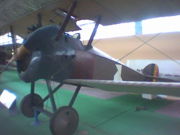 (Image:
Belgian Camel preserved at the Musée Royal de l'Armée et de l'Histoire Militaire in Brussels)
(Image:
Belgian Camel preserved at the Musée Royal de l'Armée et de l'Histoire Militaire in Brussels)
The Camel was, however, a superlative fighter, and offered heavier armament and better performance than the Pup and Triplane. In the hands of an experienced pilot, its maneuverability was unmatched by any contemporary type. Its controls were light and sensitive. The Camel turned rather slowly to the left which resulted in a nose up attitude due to the torque of the rotary engine, but turned very sharply to the right which resulted in a nose down attitude. Many pilots preferred to turn left by turning 270 degrees to the right. Because it was tail heavy, the plane also looped quickly. Agility in combat made the Camel one of the best-remembered Allied aircraft of the First World War. It was said to offer a choice between a "wooden cross, red cross and Victoria Cross." Together with the S.E.5a, the Camel helped to wrest aerial superiority away from the German Albatros fighters. The Camel was credited with shooting down 1,294 enemy aircraft, more than any other Allied fighter.
Major William Barker's Sopwith Camel (serial no. B6313, the aircraft in which the majority of his victories were scored) became the most successful fighter aircraft in the history of the RAF, shooting down 46 aircraft and balloons from September 1917 to September 1918 in 404 operational hours flying. It was dismantled in October 1918. Barker kept the clock as a memento, but was asked to return it the following day.
By mid-1918 the Camel was becoming obsolescent as a fighter, limited by its slow speed and comparatively poor performance at altitudes over 12,000 ft (3,650 m). It found a new lease of life as a ground-attack and infantry support aircraft. During the German offensive of March 1918, flights of Camels harassed the advancing German Army, inflicting high losses (and suffering high losses in turn) through the dropping of 25lb (11 kg) Cooper bombs and ultra-low-level strafing. The protracted development of the Camel's replacement, the Sopwith Snipe, meant that the Camel remained in service until the Armistice.
In summer 1918 a 2F.1 Camel (N6814) was used in trials as a parasite fighter under Airship R23
Variants
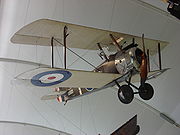 (Image:
Sopwith Camel at the RAF Museum, London)
(Image:
Sopwith Camel at the RAF Museum, London)
The Camel was powered by a variety of rotary engines during the production period.
130 hp Clerget 9B Rotary (standard powerplant)
140 hp Clerget 9Bf Rotary
110 hp Le Rhone 9J Rotary
150 hp Bentley BR1 rotary (gave best performance - standard for R.N.A.S. machines)
100 hp Gnome Monosoupape 9B-2 Rotary
150 hp Gnome Monosoupape 9N Rotary
Engine variants
-With rotary engines, the crankshaft remained fixed while the cylinders and attached propeller rotated around it. The result of this torque was a significant "pull" to the right. In the hands of an experienced pilot, this characteristic could be exploited to give exceptional maneuverability in a dogfight. A 3/4 turn to the right could be done in the same time as a 1/4 turn to the left.
-The Gnome "mono" engines did not have throttles and were at full "throttle" while the ignition was on - they could be "throttled" with a selector switch which cut the ignition to some of the cylinders to reduce power for landing. The Clerget, Le Rhone and BR1 had throttles, although reducing power involved simultaneously adjusting the mixture and was not straightforward, so it became common during landing to "blip" the engine (turn the ignition off and on) using a control column-mounted ignition switch, the blip switch, to reduce power.
Sopwith Camel F.1
Single-seat fighter ("scout") aircraft.
The main production version. Armed with twin synchronised Vickers guns.
Sopwith Camel 2F.1
Shipboard fighter scout aircraft.
Slightly shorter wingspan
One Vickers gun replaced by an overwing Lewis gun
Bentley BR1 as standard engine
Sopwith Camel "Comic" Night fighter
Pilot seat moved to rear. The twin Vickers guns were replaced with two Lewis guns firing forward over the top wing on Foster mountings. Served with Home Defence Squadrons against German air raids. The "Comic" nickname was of course unofficial, and was shared with the night fighter version of the Sopwith 1½ Strutter.
F.1/1
Version with tapered wings.
(Trench Fighter) T.F.1
Experimental trench fighter.
Downward angled machine guns
Armour plating for protection
Operators
Australia
Australian Flying Corps
No. 4 Squadron AFC in France.
No. 5 (Training) Squadron AFC in the United Kingdom.
No. 6 (Training) Squadron AFC in the United Kingdom.
No. 8 (Training) Squadron AFC in the United Kingdom.
Belgium
Belgian Air Force
Canada
Royal Canadian Air Force
Estonia
Estonian Air Force
Greece
Hellenic Air Force
Latvia
Latvian Air Force
Netherlands
Royal Netherlands Air Force
Poland
Polish Air Force operated 1 Camel post-war (1921)
Sweden
Swedish Air Force
United Kingdom
Royal Flying Corps / Royal Air Force
No. 3 Squadron RAF
No. 17 Squadron RAF
No. 28 Squadron RAF
No. 37 Squadron RAF
No. 43 Squadron RAF
No. 44 Squadron RAF
No. 45 Squadron RAF
No. 46 Squadron RAF
No. 47 Squadron RAF
No. 50 Squadron RAF
No. 51 Squadron RAF
No. 54 Squadron RAF
No. 61 Squadron RAF
No. 65 Squadron RAF
No. 66 Squadron RAF
No. 70 Squadron RAF
No. 71 Squadron RAF
No. 73 Squadron RAF
No. 75 Squadron RAF
No. 78 Squadron RAF
No. 80 Squadron RAF
No. 81 Squadron RAF
No. 89 Squadron RAF
No. 94 Squadron RAF
No. 112 Squadron RAF
No. 139 Squadron RAF
No. 143 Squadron RAF
No. 150 Squadron RAF
No. 151 Squadron RAF
No. 152 Squadron RAF
No. 155 Squadron RAF
No. 187 Squadron RAF
No. 188 Squadron RAF
No. 189 Squadron RAF
No. 198 Squadron RAF
No. 201 Squadron RAF
No. 203 Squadron RAF
No. 204 Squadron RAF
No. 208 Squadron RAF
No. 209 Squadron RAF
No. 210 Squadron RAF
No. 212 Squadron RAF
No. 213 Squadron RAF
No. 219 Squadron RAF
No. 220 Squadron RAF
No. 222 Squadron RAF
No. 225 Squadron RAF
No. 230 Squadron RAF
No. 233 Squadron RAF
No. 273 Squadron RAF
Royal Naval Air Service
No. 1 Squadron RNAS
No. 3 Squadron RNAS
No. 4 Squadron RNAS
No. 6 Squadron RNAS
No. 8 Squadron RNAS
No. 9 Squadron RNAS
No. 10 Squadron RNAS
No. 13 Squadron RNAS
United States
United States Army Air Service
9 Aero Squadron
17 Aero Squadron
27 Aero Squadron
37 Aero Squadron
148 Aero Squadron
Survivors
There are only seven authentic Sopwith Camels left in the world.
One is in the Aerospace Education Center in Little Rock, Arkansas, United States.
One, restored to near-flying condition, is at the Brussels Air Museum Restoration Society (BAMRS) in Brussels, Belgium.
A model F.1 (s/n B 7280) can be found at the Polish Aviation Museum. This Camel first flew in Royal Naval Air Service and then in the Royal Flying Corps. Two pilots who flew this aircraft shot down 11 German planes in total.
N6812, the Sopwith 2F1 Camel flown by Flight Sub Lieutenant Stuart Culley when he shot down Zeppelin L 53, is preserved at the Imperial War Museum in London.
N8156 (RAF) is currently on display at the Canadian Aviation Museum. Manufactured in 1918 by Hooper and Company Ltd., Great Britain, it was purchased by the RCAF in 1924 and last flew in 1967. It is currently on static display.
A replica Sopwith F.1 Camel is on display at the National Museum of the United States Air Force in Dayton, Ohio. This aircraft was built by Air Force Museum personnel from original WWI factory drawings and was completed in 1974. It is painted and marked as the Camel flown by Lt. George A. Vaughn Jr. while flying with the 17th Aero Squadron.
A replica is currently under construction by the Northern Aeroplane Workshops for the Shuttleworth Collection, and another is under construction at the Great War Flying Museum.
- In 1969 Slingsby built a flyable Type T.57 Sopwith Camel Replica powered by a 145hp Warner Scarab engine for use in a Biggles film. This aircraft is now on display at the Fleet Air Arm Museum, Yeovilton painted as B6401.
Popular culture
The Camel appears in literature and popular media as:
- The single-seater scout plane flown by the Royal Flying Corps Squadron in the semi-autobiographical, First World War air combat book Winged Victory written by Victor Maslin Yeates.
- The fighter flown by Biggles in the novels by W.E. Johns during the character's spell in 266 squadron during the First World War. He also wrote a book, The Camels Are Coming.
- The "plane" of Snoopy in the Peanuts comic strip, when he imagines himself as a First World War flying ace and the nemesis of the Red Baron. The Red Baron frequently shoots him down, and in fact, Snoopy was forced to wash dishes once for "losing too many Sopwith Camels". The "Sopwith Camel" is actually his doghouse. The Camel's dedicated mechanic was none other than Woodstock, and the ground crew was Snoopy's bird friends. (When Marcie asked Snoopy "midflight" why his plane was so clean, Snoopy replied, "I have a dedicated mechanic." The punch line was that Woodstock sprayed Marcie with a hose just at that moment.)
- The type of aircraft flown in the First World War by John and Bayard Sartoris in William Faulkner's Flags in the Dust. Under fire from a pupil of Richthofen (the Red Baron), John's Camel caught fire over occupied France. Bayard's last sight of his twin brother was of John jumping out of his fighter feet first. Faulkner also wrote about the Camel (and Sartoris) in his famous story All the Dead Pilots.
- Bartholomew Bandy flies a Camel in the first "Bandy Papers" book by Donald Jack, Three Cheers for Me.
- subLOGIC Flight Simulator featured the Sopwith Camel in Flight Simulator II. (Before Flight Simulator was licensed to Microsoft).
 - A 2-D air-combat computer game called "Sopwith Camel" using CGA graphics was available for DOS. It featured bombing missions and dogfights against enemy planes, as well as a basic physics engine and bird-strike.
- A 2-D air-combat computer game called "Sopwith Camel" using CGA graphics was available for DOS. It featured bombing missions and dogfights against enemy planes, as well as a basic physics engine and bird-strike.
- Microsoft Flight Simulator Series featured the Camel in versions FS3.0, FS4.0, FS5.0, FS5.1, FS95, FS98, FS2000, and FS2002.
- First Eagles a WW1 combat simulator by Thirdwire features the Camel F1 in three different versions (110hp,130hp and 150hp)
Specifications (F.1 Camel)
General characteristics
 -Crew: 1
-Crew: 1
-Length: 18 ft 9 in (5.71 m)
-Wingspan: 26 ft 11 in (8.53 m)
-Height: 8 ft 6 in (2.59 m)
-Wing area: 231 ft² (21.46 m²)
-Empty weight: 930 lb (420 kg)
-Loaded weight: 1,455 lb (660 kg)
-Powerplant: 1× Clerget 9B 9-cylinder Rotary engine, 130 hp (97 kW)
-Zero-lift drag coefficient: 0.0378
-Drag area: 8.73 ft² (0.81 m²)
-Aspect ratio: 4.11
Performance
-Maximum speed: 115 mph (185 km/h)
-Stall speed: 48 mph (77 km/h)
-Range: 300 mi ferry (485 km)
-Service ceiling 21,000 ft (6,400 m)
-Rate of climb: 1,085 ft/min (5.5 m/s)
-Wing loading: 6.3 lb/ft² (30.8 kg/m²)
-Power/mass: 0.09 hp/lb (150 W/kg)
-Lift-to-drag ratio: 7.7
Armament
-Guns: 2× 0.303 in (7.7 mm) Vickers machine guns
Source: WikiPedia